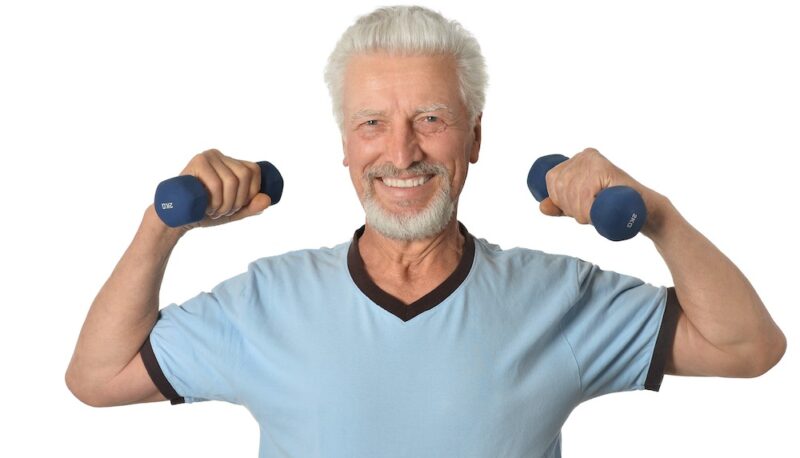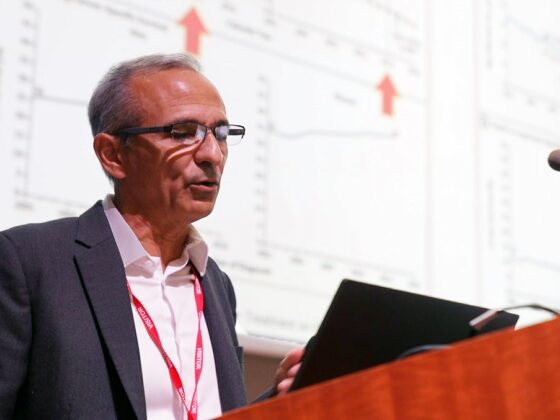After a bout of high-intensity interval training, men with advanced prostate cancer showed acute elevations of anti-cancer myokines in their serum. The study, published in Prostate Cancer and Prostatic Diseases, (29 November 2022), then demonstrated growth suppression of prostate cancer cell lines exposed to serum obtained immediately post exercise.
“The findings from our work are particularly exciting because we report for the first time ever that men with advanced prostate cancer are able to produce an acute elevation in anti-cancer molecules called myokines in response to a single bout of vigorous exercise,” says Rob Newton, Professor of Exercise Medicine and an accredited exercise physiologist from the Exercise Medicine Research Institute at Edith Cowan University, Australia. “This is helping us to understand why patients with cancer who exercise exhibit slower disease progression and survive for longer.”
Associations between increased volume and intensity of physical activity and reduced cancer-related mortality and disease progression have been reported in observational studies, providing a strong case for men with prostate cancer to engage in exercise. Recently, skeletal muscle has been shown to have a substantial endocrine function through the synthesis and secretion of cytokines that are released in response to muscular contraction (termed myokines), which are known known to have autocrine, paracrine and endocrine effects. However, due to lack of research there has been limited understanding of the endocrine role of skeletal muscle on tumour suppression in people who already have cancer.
In their first study, published in Med Sci Sports Exercise in February 2022, Newton and colleagues demonstrated that obese men with prostate cancer undergoing androgen deprivation therapy increased levels of circulating myokines following three months of exercise training, and that post training blood serum suppressed growth of prostate cancer cell lines. “This study demonstrated that men with metabolic dysregulation who were chemically castrated retained the capacity within their muscles to respond to exercise training with increased resting myokine levels despite low muscle mass, high fat mass and no testosterone signalling in their body,” Newton told Cancerworld.
In a second study, published in Prostate Cancer Prostatic Disease in March 2022, the team demonstrated that men with advanced prostate cancer who had undergone extensive cancer treatments retained the capacity to increase resting myokine levels in response to six months’ exercise training, and that myokines reduced growth of prostate cancer cell lines. The study, explains Newton, demonstrated that even men with advanced prostate cancer can elicit a myokine response to exercise.
In the current study, Newton and colleagues set out to examine myokine levels in serum collected before and after a single bout of high-intensity interval aerobic exercise in trained patients (who had completed three months of exercise intervention) with metastatic castrate-resistant prostate cancer (mCRPC) undergoing androgen therapy. Altogether, nine patients with mCRPC, average age 67.8 years, performed 34 minutes of high-intensity exercise on a stationary cycle, with blood serum collected immediately before and after, and then again 30 minutes following the workout. Serum levels of secreted protein acidic and rich in cysteine (SPARC), oncostatin M (OSM), interleukin-6 (IL-6), interleukin-15 (IL-15), decorin, irisin, and IGF-1 were determined. Finally, growth of the human androgen-independent prostate cell line DU-145 was measured after exposure to serum collected at the three time points.
Results of serum collected immediately after exercise (in comparison to at baseline) showed significant elevation of SPARC (19.9%, P=0.0048); OSM (11.5%, P=0.001); IL-6 (10.2%, P=0.02); and IL-15 (7.8%, P=0.023). Levels returned to baseline after 30 minutes rest. A significant reduction in cell growth and the Cell Index area under the curve was observed in comparison to baseline when the DU-145 cell line was exposed to the serum immediately post-exercise (Cell Index at 72 h: 16.9%, P<0.001; area under the curve: 15.2%, P<0.001) and 30 minutes post-exercise (Cell Index at 72 h: 6.5%; area under the curve 8.8%, P<0.001).
“This study extends on the previous work by demonstrating that each exercise session provides a further dose of cancer suppressive endogenous medicine,” explains Newton. It suggests, he adds, that patients should be performing a bout of exercise most days of the week to provide further dosing of their cancer with suppressive myokines. “These patients are palliative, so there is no cure and they will eventually succumb – however, there is evidence that exercise will extend survival and the increased myokine levels… is a prime mechanism,” says Newton, adding that the result can immediately be used to help shape advice given to cancer patients.
“This study provides strong evidence for the recommendation that patients with prostate cancer, and likely anybody with any cancer type, should perform exercise most days, if not every day to maintain a chemical environment within the body which is suppressive of cancer cell proliferation,” he explains.
The optimal dose of exercise, Newton adds, is not yet known. “But it’s likely to be 20-plus minutes each day and must include resistance training to grow the muscles, increase the size and capacity of the internal pharmacy, and stimulate the myokine production,” he says.
Understanding the mechanisms by which exercise results in suppression of cancer progression is important not only for the direct effects but also to inform the development of new therapeutic agents that could facilitate the effects of exercise.
Ongoing studies are now looking at combinations of resistance and aerobic exercise to explore which mode of exercise produces the greatest myokine benefits, and what dosage is most effective in terms of volume, intensity and timing. The team are also investigating the influence of myokines on immunological responses, and whether there is a relationship between myokine response and the muscle mass of patients. “It’s now well understood that the muscular system is one of the pharmacies within the body dispensing very powerful endogenous medicines, so it’s likely that the larger this pharmacy the more anticancer medicine it can produce,” says Newton. The suppressive effects of myokines, he adds, have been demonstrated in a range of cancers, including breast. “We believe that the exercise induced myokine benefits can be realised regardless of the cancer type or stage,” he says.












